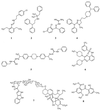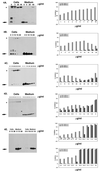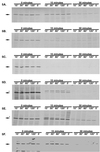Identification and analysis of bacterial protein secretion inhibitors utilizing a SecA-LacZ reporter fusion system
- PMID: 10817687
- PMCID: PMC89891
- DOI: 10.1128/AAC.44.6.1418-1427.2000
Identification and analysis of bacterial protein secretion inhibitors utilizing a SecA-LacZ reporter fusion system
Abstract
Protein secretion is an essential process for bacterial growth, yet there are few if any antimicrobial agents which inhibit secretion. An in vivo, high-throughput screen to detect secretion inhibitors was developed based on the translational autoregulation of one of the central protein components, SecA. The assay makes use of a SecA-LacZ fusion reporter construct in Escherichia coli which is induced when secretion is perturbed. Several compounds, including two natural product extracts, which had the ability to induce the reporter fusion were identified and the MICs of these compounds for Staphylococcus aureus strain MN8 were found to be < or =128 microg/ml. Enzyme-linked immunosorbent assay, Western blotting, and immunoprecipitation techniques were used to analyze the affects of these compounds on protein secretion. Six representative compounds presented here appear to be bona fide secretion inhibitors but were found to have deleterious effects on membranes. It was concluded that, while the method described here for identifying inhibitors of secretion is valid, screens such as this, which are directed against the membrane-bound portion of a pathway, may preferentially identify compounds which affect membrane integrity.
Figures





References
-
- Abbanat D A, Singh M P, Greenstein M. Hongoquercins, new antibacterial agents from the fungus LL-23G227: fermentation and biological activity. J Antibiot. 1998;51:708–714. - PubMed
-
- Barrett J F, Goldschmidt R M, Lawrence L E, Foleno B, Chen R, Demers J P, Johnson S, Kanojia R, Fernandez J, Bernstein J, Licata L, Donetz A, Huang S, Hlasta D J, Macielag M J, Ohemeng K, Frechette R, Frosco M B, Klaubert D H, Whiteley J M, Wang L, Hoch J A. Antibacterial agents that inhibit two-component signal transduction systems. Proc Natl Acad Sci USA. 1998;95:5317–5322. - PMC - PubMed
-
- Blomster-Hautamaa D A, Kreiswirth B N, Kornblum J S, Novick R P, Schlievert P M. The nucleotide and partial amino acid sequence of toxic shock syndrome toxin-1. J Biol Chem. 1986;261:15783–15786. - PubMed
-
- Casadaban M J, Cohen S N. Analysis of gene control signals by DNA fusion and cloning in Escherichia coli. J Mol Biol. 1980;138:179–207. - PubMed
-
- Chopra I, Hacker K. Uptake of minocycline by Escherichia coli. J Antimicrob Chemother. 1992;29:19–25. - PubMed
MeSH terms
Substances
LinkOut - more resources
Full Text Sources
Other Literature Sources
Medical

